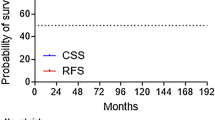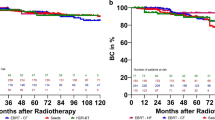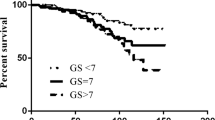Abstract
Background and purpose
To evaluate the effectiveness of high-dose-rate interstitial brachytherapy (HDR-ISBT) as the only form of radiotherapy for high-risk prostate cancer patients.
Patients and methods
Between July 2003 and June 2008, we retrospectively evaluated the outcomes of 48 high-risk patients who had undergone HDR-ISBT at the National Hospital Organization Osaka National Hospital. Risk group classification was according to the criteria described in the National Comprehensive Cancer Network (NCCN) guidelines. Median follow-up was 73 months (range 12–109 months). Neoadjuvant androgen deprivation therapy (ADT) was administered to all 48 patients; 12 patients also received adjuvant ADT. Maximal androgen blockade was performed in 37 patients. Median total treatment duration was 8 months (range 3–45 months). The planned prescribed dose was 54 Gy in 9 fractions over 5 days for the first 13 patients and 49 Gy in 7 fractions over 4 days for 34 patients. Only one patient who was over 80 years old received 38 Gy in 4 fractions over 3 days. The clinical target volume (CTV) was calculated for the prostate gland and the medial side of the seminal vesicles. A 10-mm cranial margin was added to the CTV to create the planning target volume (PTV).
Results
The 5-year overall survival and biochemical control rates were 98 and 87 %, respectively. Grade 3 late genitourinary and gastrointestinal complications occurred in 2 patients (4 %) and 1 patient (2 %), respectively; grade 2 late genitourinary and gastrointestinal complications occurred in 5 patients (10 %) and 1 patient (2 %), respectively.
Conclusion
Even for high-risk patients, HDR-ISBT as the only form of radiotherapy combined with ADT achieved promising biochemical control results, with acceptable late genitourinary and gastrointestinal complication rates.
Zusammenfassung
Hintergrund und Zweck
Beurteilung der Wirksamkeit von interstitieller Brachytherapie mit Hochdosisraten („high-dose-rate interstitial brachytherapy“, HDR-ISBT) als einzige Form der Radiotherapie für Hochrisiko-Prostatakarzinompatienten.
Patienten und Methodik
Zwischen Juli 2003 und Juni 2008 werteten wir retrospektiv die Ergebnisse von 48 Patienten mit hohem Risiko aus, die im National Hospital Organization Osaka National Hospital mittels HDR-ISBT behandelt worden waren. Die Klassifikation der Risikogruppen wurde gemäß der Richtlinien des „National Comprehensive Cancer Network“ (NCCN) durchgeführt. Die mittlere Nachbeobachtungszeit betrug 73 Monate (Bereich 12–109 Monate). Eine neoadjuvante Androgendeprivationstherapie (ADT) erhielten alle 48 Patienten, darunter 12 Patienten zusätzlich als adjuvante Behandlung. Einer maximalen Androgenblockade unterzogen sich 37 Patienten. Die Gesamtbehandlungszeit umfasste im Mittel 8 Monate (Bereich 3–45 Monate). Die geplante vorgeschriebene Dosis betrug bei den ersten 13 Patienten 54 Gy in 9 Fraktionen über 5 Tage bzw. bei den anderen 34 Patienten 49 Gy in 7 Fraktionen über 4 Tage. Nur ein einziger Patient im Alter von über 80 Jahren erhielt eine Dosis von 38 Gy in 4 Fraktionen über 3 Tage. Das klinische Zielvolumen (CTV) wurde für die Prostatadrüse und die mediale Seite der Samenblase (SV) berechnet. Ein 10 mm breiter kranialer Rand wurde dem CTV als Planzielvolumen (PTV) hinzugefügt.
Ergebnisse
Die Gesamtüberlebensrate und die biochemische Kontrollrate über 5 Jahre betrug 98 bzw. 87 %. Späte Grad-3-Urogenital- und -Gastrointestinalkomplikationen traten bei 2 bzw. 1 Patienten (4 bzw. 2 %) auf, während späte Grad-2-Urogenital- und -Gastrointestinalkomplikationen bei 5 bzw. 1 Patienten (10 bzw. 2 %) festgestellt wurden.
Schlussfolgerung
Auch bei Hochrisiko-Patienten erzielte die HDR-ISBT als alleinige Form der Radiotherapie in Kombination mit ADT vielversprechende biochemische Kontrollergebnisse mit akzeptablen späten urogenitalen und gastrointestinalen Komplikationsraten.

Similar content being viewed by others
References
Barkati M, Williams SG, Foroudi F et al (2012) High-dose-rate brachytherapy as a monotherapy for favorable-risk prostate cancer: a Phase II trial. Int J Radiat Oncol Biol Phys 82:1889–1896
Challapalli A, Jones E, Harvey C et al (2012) High dose rate prostate brachytherapy: an overview of the rationale, experience and emerging applications in the treatment of prostate cancer. Br J Radiol 85:18–27
Demanes DJ, Martinez AA, Ghilezan M et al (2011) High-dose-rate monotherapy: safe and effective brachytherapy for patients with localized prostate cancer. Int J Radiat Oncol Biol Phys 81:1286–1292
Galalae RM, Kovacs G, Schultze J et al (2002) Long-term outcome after elective irradiation of the pelvic lymphatics and local dose escalation using high-dose-rate brachytherapy for locally advanced prostate cancer. Int J Radiat Oncol Biol Phys 52:81–90
Ghadjar P, Keller T, Rentsch CA et al (2009) Toxicity and early treatment outcomes in low- and intermediate-risk prostate cancer managed by high-dose-rate brachytherapy as a monotherapy. Brachytherapy 8:45–51
Grills IS, Martinez AA, Hollander M et al (2004) High dose rate brachytherapy as prostate cancer monotherapy reduces toxicity compared to low dose rate palladium seeds. J Urol 171:1098–1104
Hoskin P, Rojas A, Lowe G et al (2012) High-dose-rate brachytherapy alone for localized prostate cancer in patients at moderate or high risk of biochemical recurrence. Int J Radiat Oncol Biol Phys 82:1376–1384
Jacob R, Hanlon AL, Horwitz EM et al (2005) Role of prostate dose escalation in patients with greater than 15 % risk of pelvic lymph node involvement. Int J Radiat Oncol Biol Phys 61:695–701
Komiya A, Fujiuchi Y, Ito T et al (2013) Early quality of life outcomes in patients with prostate cancer managed by high-dose-rate brachytherapy as monotherapy. Int J Urol 20:185–192
Kovács G, Pötter R, Loch T et al (2005) GEC/ESTRO-EAU recommendations on temporary brachytherapy using stepping sources for localised prostate cancer. Radiother Oncol 74:137–148
Krauss DJ (2013) HDR brachytherapy alone for high-risk prostate cancer: a safe approach for patients with localized disease? Int J Radiat Oncol Biol Phys 85:1161–1162
Lawton CA, DeSilvio M, Roach M 3rd et al (2007) An update of the phase III trial comparing whole pelvic to prostate only radiotherapy and neoadjuvant to adjuvant total androgen suppression: updated analysis of RTOG 94–13, with emphasis on unexpected hormone/radiation interactions. Int J Radiat Oncol Biol Phys 69:646–655
Martin T, Baltas D, Kurek R et al (2004) 3-D conformal HDR brachytherapy as monotherapy for localized prostate cancer. A pilot study. Strahlenther Onkol 180:225–232
Martinez A, Pataki I, Edmundson G et al (2001) Phase II prospective study of the use of conformal high-dose-rate brachytherapy as monotherapy for the treatment of favorable stage prostate cancer: a feasibility report. Int J Radiat Oncol Biol Phys 49:61–69
Mate TP, Gottesman JE, Hatton J et al (1998) High dose-rate afterloading Ir-192 prostate brachytherapy: feasibility report. Int J Radiat Oncol Biol Phys 41:525–533
Pommier P, Chabaud S, Lagrange JL et al (2007) Is there a role for pelvic irradiation in localized prostate adenocarcinoma? Preliminary results of GETUG-01. J Clin Oncol 25:5366–5373
Prada PJ, Jimenez I, González-Suárez H et al (2012) High-dose-rate interstitial brachytherapy as monotherapy in one fraction and transperineal hyaluronic acid injection into the perirectal fat for the treatment of favorable stage prostate cancer: treatment description and preliminary results. Brachytherapy 11:105–110
Roach M 3rd, DeSilvio M, Valicenti R et al (2006) Whole-pelvis, “mini-pelvis,” or prostate-only external beam radiotherapy after neoadjuvant and concurrent hormonal therapy in patients treated in the Radiation Therapy Oncology Group 9413 trial. Int J Radiat Oncol Biol Phys 66:647–653
Rogers CL, Alder SC, Rogers RL et al (2012) High dose brachytherapy as monotherapy for intermediate risk prostate cancer. J Urol 187:109–116
Takenaka T, Yoshida K, Ueda M et al (2012) Assessment of daily needle applicator displacement during high-dose-rate interstitial brachytherapy for prostate cancer using daily CT examinations. J Radiat Res 53:469–474. http://www.ncbi.nlm.nih.gov/pubmed/22485020
Vargas CE, Demanes J, Boike TP et al (2006) Matched-pair analysis of prostate cancer patients with a high risk of positive pelvic lymph nodes treated with and without pelvic RT and high-dose radiation using high dose rate brachytherapy. Am J Clin Oncol 29:451–457
Yamada Y, Rogers L, Demanes DJ et al (2012) American Brachytherapy Society consensus guidelines for high-dose-rate prostate brachytherapy. Brachytherapy 11:20–32
Yoshida K, Nose T, Shiomi H et al (2006) New ambulatory implant technique of high-dose-rate interstitial brachytherapy for prostate cancer. Radiat Med 24:595–599
Yoshida K, Kuroda S, Yoshida M et al (2007) New implant technique for separation of seminal vesicle and rectal mucosa for high-dose-rate prostate brachytherapy. Brachytherapy 6:180–186
Yoshida K, Yamazaki H, Nose T et al (2010) Needle applicator displacement during high-dose-rate interstitial brachytherapy for prostate cancer. Brachytherapy 9:36–41
Yoshida K, Nose T, Koizumi M et al (2002) The usefulness of metal markers for CTV-based dose prescription in high-dose-rate interstitial brachytherapy. J Jpn Soc Ther Radiol Oncol 13:253–260
Yoshioka Y, Konishi K, Sumida I et al (2011) Monotherapeutic high-dose-rate brachytherapy for prostate cancer: five-year results of an extreme hypofractionation regimen with 54 Gy in nine fractions. Int J Radiat Oncol Biol Phys 80:469–475
Yoshioka Y, Nose T, Yoshida K et al (2000) High-dose-rate interstitial brachytherapy as a monotherapy for localized prostate cancer: Treatment description and preliminary results of a phase I/II clinical trial. Int J Radiat Oncol Biol Phys 48:675–681
Yoshioka Y, Nose T, Yoshida K et al (2003) High-dose-rate brachytherapy as monotherapy for localized prostate cancer: a retrospective analysis with special focus on tolerance and chronic toxicity. Int J Radiat Oncol Biol Phys 56:213–220
Yoshioka Y, Konishi K, Oh RJ et al (2006) High-dose-rate brachytherapy without external beam irradiation for locally advanced prostate cancer. Radiother Oncol 80:62–68
Yoshioka Y, Suzuki O, Kobayashi K et al (2009) External-beam radiotherapy for clinically localized prostate cancer in Osaka, Japan, 1995–2006: time trends, outcome, and risk stratification. Strahlenther Onkol 185:446–452. http://www.ncbi.nlm.nih.gov/pubmed/19714306
Zamboglou N, Tselis N, Baltas D et al (2013) High-dose-rate interstitial brachytherapy as monotherapy for clinically localized prostate cancer: treatment evolution and mature results. Int J Radiat Oncol Biol Phys 85:672–678
Compliance with ethical guidelines
Conflict of interest
K. Yoshida, H. Yamazaki, T. Takenaka, T. Kotsuma, M. Yoshida, K. Masui, Y. Yoshioka, Y. Narumi, T. Oka and E. Tanaka state that there are no conflicts of interest.
Author information
Authors and Affiliations
Corresponding author
Rights and permissions
About this article
Cite this article
Yoshida, K., Yamazaki, H., Takenaka, T. et al. High-dose-rate interstitial brachytherapy in combination with androgen deprivation therapy for prostate cancer. Strahlenther Onkol 190, 1015–1020 (2014). https://doi.org/10.1007/s00066-014-0675-4
Received:
Accepted:
Published:
Issue Date:
DOI: https://doi.org/10.1007/s00066-014-0675-4




